|
The Second Battle of Talabecland
A DBMM Battle Report
by James Cheung





Introduction
In 1320 Herbert, Grand Master of the Teutonic Knights and James, Crown
Prince and Duke of Brandenburg of the Holy Roman Empire have a territorial
dispute over the ownership of a little town known as
Talabecland on the border between the two lords.
In summer that year Grant Master Herbert invaded and attacked James
with a huge army.


Herbert was able to inflict a defeat on James at the First Battle of
Talabecland. Defeated but not
shattered, James retreated and gathered another army and marched against
Herbertís new position on the Talabecland.


Set Up
Players : Herbert as Grand Master of the Teutonic Knight, James as the Crown
Prince and Duke of Brandenburg
Army List : Selection based on DBMM Book IV/13 Medieval German and IV/30
Teutonic Knights after 1300AD
Scale : 600pts per side with all Stratagems allowed
Attacker : German Defender :
Teutonic Knights

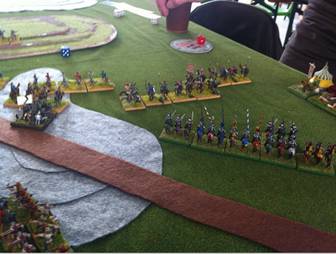
Commanders
Herbert Wong, a wily old veteran with many victories under his belt, led the
Teutonic Knights. He is cunning and experienced in all kind of
situations. James Cheun, who is also an experienced commander and of
no less calibre than Herbert, led the German army.


The Battlefield
The battle happened at the outskirts of a little town known as Talabecland.
To the south of the town there is a little river running towards the
town and then runs eastward. To
the west of the river there is a large forest covering the whole of the
right wing of the German line.
The surroundings of the town are basically open scattered countryside with
only some small wooded areas and boggy fields.
There is also a road running though the town from the riverwhich
turns eastward.
German Side
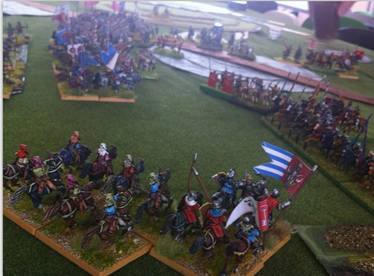
Teutonic Side
The Armies and the Plan
The Teutonic Knights had three commands. A Brother sub-general
commanded the left wing and contained 3three doubled based Brother Knights
in wedge formation and some cavalry.
They were placed on the south side of the town and between the north
banks of the river and were supported by several archers positioned on the
south bank of the river to guard for any outflanking force.
The role of this command is at first holding the left of the Teutonic
line and watcing for any out flanking movement.
But if the right moment arrives then it will launch the attack on the
right of the German Line and would also be one of the arms of the classic
double envelopment.


The Centre, the largest among the three commands, was led by the C-in-C
himself. Several lesser
Teutonic knights were positioned on the north side of the town.
Inside the town there were four elements of psiloi.
To the right of these knights there was a deep defensive line of
spearmen in about eight to nine elements width. There were also three light
horse elements guarding the flank of the spearmen.


All of the feudal irregular knights from friendly non-German lords were
personally commanded by Herbert and positioned behind the spearmen.
The lesser knights and the spearmen were to form a defensive line and
to lure the Germans into attack.
They were the anvil of the force.
Should the line absorb the German attack then the left wing and the
right outflanking force would conduct a classic double envelopment.
The feudal knights were going to support the outflanking force and
would be repositioned to the right wing.


The last command, being led by another Brother sub-general, comprised all
the hordes, auxilia, light horse and the remaining cavalry and Brother
Knight (total numbering twenty-eight elements) and was sent on a flanking
march to the left of the German side.
Supported by the feudal knights from the centre, this command would
be the hammer and the striking force of the Teutonic Knights.


Taking account of the experience of his last defeat, James took more
infantry to the battle. The German had four commands. An allied general from
a friendly duke commanded the right wing.
It had twelve spearmen Reg Sp(I) supported by 6six psiloi Reg Ps(O).
It also had eight Reg Bw(I) and two Reg Kn(O).
It had also some hordes at the rear to protect the baggage.
This command was intended to be a delaying or covering force.
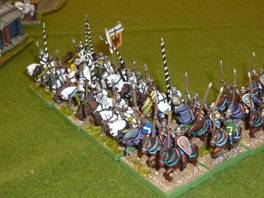

The centre was commanded by the C-in-C.
It had the secret weapon of the army, the Heerban IrrBd(X), the
knight killer. Bd(X) can quick kill knight in both bounds and was the trump
card of James. To let the Bd(X)
be more effective, it had the Dukeís standard wagon RegBg(S) stationed just
behind the Heerban. Thus those
Heerban touching the wagon could enjoy a +1 benefit in CC.
This command had a reserve of seven Reg Kn(O) acting as a force to
exploit any breakthrough created by the Heerban or to act as fire brigade.


A sub-general commanded the left wing.
It had sixteen mercenary axemen Reg Bd(I) supported by eight psiloi.
Ten axemen were to support the advance of the Heerban and thus placed
to the left of the Heerban.
Since an outflanking force to the left by the Teutonic Knight seemed very
likely, the remaining six axemen together with four knights were placed as
reserve to cover the left flank.


Herbertís plan was simple. He would
do nothing before the arrival of his out-flanking force except repositioning
his irregular knights to the right in order to support the outflanking
force. When the outflanking
force arrived nearly half of his army will fall upon on the German left
flank. The left wing would also
advance in order to complete the double envelopment.


Jamesí plan was just the opposite of that of Herbert.
Judging that a large portion of Herbertís force was missing off the
table, James knew that the main attack from Herbert would be on his left
flank since his right flank was already covered by a large forest.
Thus Jamesí plan was simple.
He hoped both his flanks could delay Herbertís long enough so
that his Heerban and axemen could crush Herbertís centre.
He also hoped that his small outflanking force would further delay
Herbertís large out-flanking movement.


The Battle
This was a beautiful summer's day and the battle started at 06:00.
The first one and half hours saw little action on both sides, except
that Herbertí repositioned his irregular knights to his right.
James also hurriedly redeployed his knights from the centre to his
left flank.


However, the Jamesí redeployment was slow as he was hampered by low pip
dice. Nevertheless his centre,
containing all the Heerban, ten elements of axemen and four elements of
RegBW(O) advanced slowly toward Hebertís defensive line.
They were also supported by eight RegBW(I) from the ally general and
facing the town.
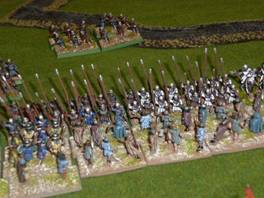

Should the psiloi advance from the town these bowmen would shot them into
pieces. James just hoped that
Herbertís outflanking force would never arrive or after it did, he could
form a defensive line facing the oncoming onslaught.
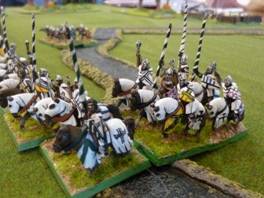

At 07:20 James was notified that his small out-flanking force had been
driven back by Herbertís larger out-flanking force.
James hastened to reform the defensive line on his left flank and
urged his centre to move forward.


At 07:30 James out-flanking force arrived on the table on his own half side.
James was also just in time to form a defensive line to cover his
left flank. This defensive line
consisted of 6 axemen supported by psiloi, all the knights of his left
command and all the seven knights from the centre.


The remaining axemen, bowmen and all the heerban were also advance into
striking distance from Herbertís defensive line in the centre.
The small outflanking force was to position to extreme left of the
line.


At 07:40 the inevitable happened.
The out-flanking force commanded by Herbert arrived on scene.
Its light horse successfully caught Jamesí small out-flanking force
in its rear and immediately destroyed two knights.
This command was then broken.
The remaining units deployed in front of Jamesí covering line but out
of striking distance. The
spearmen and the knights in the centre also attacked but luckily James
Heerban managed to quick kill most of Herbertís knights and Herbertís attack
in the centre was repulsed.


At 07:50 James continued putting pressure on Herbertís centre and
successfully killed Herbertís remaining knights in the centre.
The axemen versus spearmen turned into a seesaw battle although James
Bd(I) could quick kill spearmen.

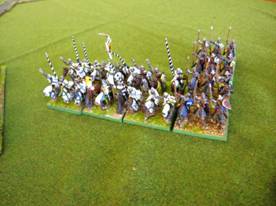
At 08:00 Herbertís double-based knight, auxilia, cavalry and those irregular
knights from the centre finally advanced to the position to strike Jamesí
covering force on his left flank.
Herbertís light horse continually played havoc to Jamesí smallest
command and finally killed the remaining two units including the
sub-general. Thus Jamesí
outflanking force was all but annihilated.
On the other hand, Herbertís centre slowly but surely was giving way
to James' Heerban and axemen.
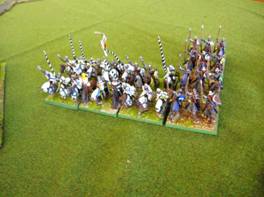

Since Herbertís outflanking force were now in striking distance of Jamesí
covering line, James immediately launchŽd an all out attack and hoped that
he could get some lucky die rolls to save the day.
It would be foolhardy to allow the doubled based knights to attack
first (the factor for a double based general is 4 +1 for double based and +1
for general and they cannot be overlapped and quick kills kill many kinds of
units). However, the coming CC
saw James throwing a lot of bad dice and the attack was heavily repulsed.
Even the centre gained little.


At 08:20 Herbertís light horse began turning the flank and overlapped James
defensive line. It seemed that
it was just a matter of time before Herbertís forces would roll up the whole
of Jamesí left flank.
At 08:30 James was still hanging on and his two commands were close to being
disheartened. Since James had
already lost a lot of knights in fighting, the disheartening of the centre
and left commands meant that the Heerban and axemen would lose their
fighting spirit (-1 in CC for units less than 2 ME due to disheartened).
If the Heerban and axemen were not able to fight then nothing could
save the day. Herbertís
battered centre command was far from disheartened and the other two commands
were even unscratched.


At 08:40 the miracle happened.
Herbert, judging that this was the right moment, committed his left wing to
attack and launch a coup de grace on Jamesí left.
At first everything went well, double-based Knights from Herbertís
left wing successfully killed a lone bowman and his right wing was doing
fine. Jamesí left wing had all
its knights killed leaving its sub-commander to fight alone.
When every thing seemed lost and James wanted to commit haki-kaki,
three to four of Herbertís knights were suddenly killed by bad dice rolls (1
vs 6) and Herbertís largest command was suddenly broken.
This command was still far from shattered (26 ME to being shattered
and James needed to inflict eight more) but the sudden change of fortune
left Hebertís C-in-C in an isolated position and prone to be overlapped.

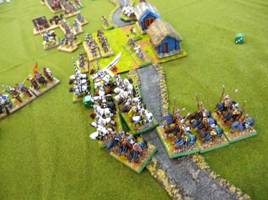
In order to save the day, James needed to inflict eight more ME on Herbertís
centre command. In order to achieve
this he ordered two knights overlapping Herbertís C-in-C and the knight next
to it before two other knights charged them head on.
Moreover, Herbertís spearmen were now suffering
-1 penalty in CC which made them more easily to quick kill by Jamesí
Heerban and axemen. In the
coming CC James successfully killed Herbertís C-in-C and his adjacent knight
as well as several spearmen.
Herbertís largest command was thus shattered and James claimed the day at
08:50.


The final outcome was a 58 ME loss for the Teutonic Knights The largest
command being shattered), compared with a 25.5 ME loss for the Germans. One
command of the German army was total wiped out and two other commands were
close to being disheartened. The other two Teutonic Knight commands
were all intact and retreated from the field in good order. The
Germans won a narrow victory.


Aftermath
The battle was a close run affair and both sides were exhausted after the
battle. James smallest commanded was annihilated.
The left as well as the centre were close to being disheartened.
Only the right wing commanded by the allies remained intact.
Of Herbertís theree commands, two commands remained intact and
suffered no loss. Only the
centre, having taken the brunt of Jamesí Heerban and axemen, suffered most.
The loss of the C-in-C also decided the fate of Herbertís army.
With the loss of his C-in-C Herbertís conceded and retreated to the
domain of the Teutonic Knights.







back to medieval |